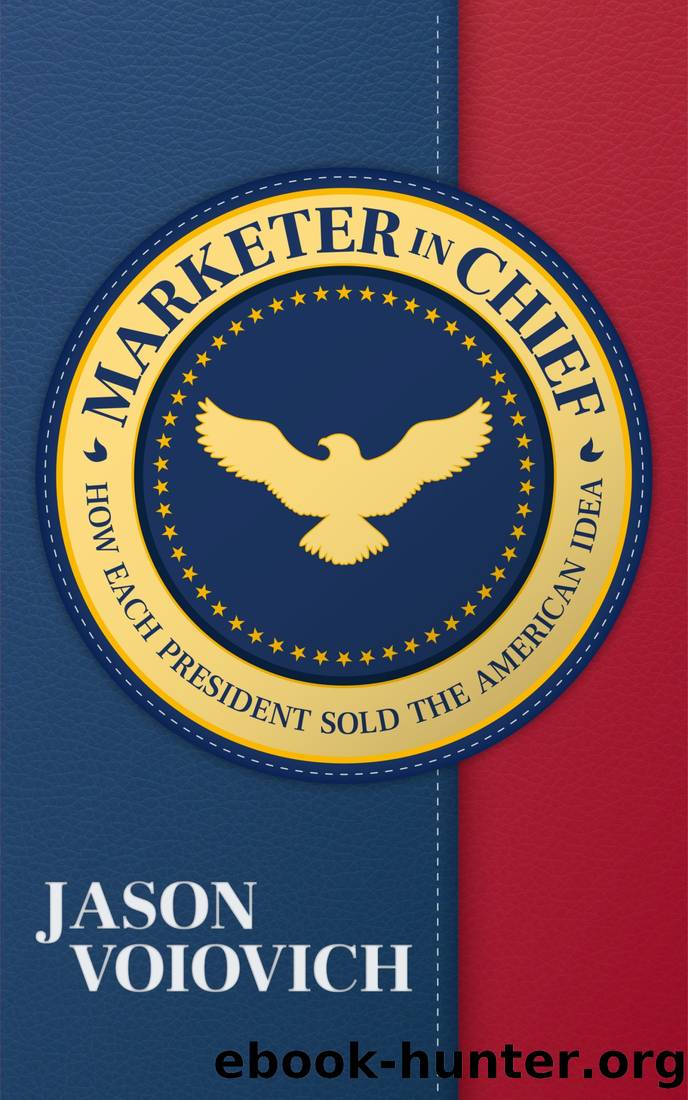Marketer in Chief: How Each President Sold the American Idea by Jason Voiovich

Author:Jason Voiovich [Voiovich, Jason]
Language: eng
Format: epub
Tags: marketing, General, history, Business & Economics, american history, Presidential History, United States, Advertising
ISBN: 9781737001317
Google: j25zzgEACAAJ
Publisher: Jaywalker Publishing LLC
Published: 2021-07-04T23:33:14.769969+00:00
Endnotes, Sources, and Further Reading
1 I get it. The Natural Resources Defense Council (NRDC) isnât an unbiased source. However, when you compare their findings to government data and industry research, the facts arenât at issue. Their 2012 issue paper, Wasted: How America Is Losing Up to 40 Percent of Its Food from Farm to Fork to Landfill, is one of the best summaries youâll find of both the issues as well as possible solutions.
2 This is the ideal scenario â buyer and user needs should drive discussions of financial profitability and technological feasibility. As you can guess, it doesnât always work that way.
3 In the United States, the Federal Trade Commission restricts the claims advertisers can make. For example, the organic food producer couldnât claim the product was organic when it wasnât. However, the definition of âorganicâ was not (and still is not) fully clarified. Food labeling is notoriously vague in a number of areas, meaning that advertisers can make plenty of claims that are technically true, but can easily mislead consumers.
4 A year later, on a vacation in Ireland, I picked up a bag of Keoghâs potato chips (crisps) with precisely this solution. I scanned the QR code with my phone and saw that my bag of chips began its life in a farm about 30 miles away.
5 Search for images of early 1900s âSears Catalogâ and âfeathered hatsâ to see for yourself.
6 The Maryland Historical Society assembled an excellent summary of this situation (complete with photos!) if youâd like to know more. Amelia Birdsallâs, A Womanâs Nature: Attitudes and Identities of the Bird Hat Debate at the Turn of the 20th Century, and Dr. Merle Patchettâs, Fashioning Feathers: Dead Birds, Millinery Crafts and the Plumage Trade, are also excellent resources.
7 When I first read David McCulloughâs Mornings on Horseback, it took me a chapter and a half to figure out that the âTheodoreâ in those early chapters was Theodore Sr. â the future Presidentâs father â and a fascinating man in his own right.
8 The Wilderness Warrior: Theodore Roosevelt and the Crusade for America, by Douglas Brinkley, is my favorite TR biography.
9 I love it when you get to hear the real exchange, even if itâs (perhaps) fictionalized or cleaned up. It tells you what people choose to remember, which is (in a way) more important than the verbatim response.
10 Iâm not a super outdoorsy kid. In fact, Iâve been described as âindoorsy.â But even I know that there is nothing in the world that quite matches the National Park Service.
11 Companies such as Sodexo understand sustainability. As the supplier to hundreds of schools, cafeterias, and businesses, the company sees food waste as a supply chain cost it canât afford in the face of shrinking margins. Americans are changing their eating habits as well. More consumers are patronizing farmersâ markets, growing their own food, and paying more attention to where food comes from in general. While many people donât have the luxury of those choices, even small changes in buyer behavior can force changes throughout the supply chain.
Download
This site does not store any files on its server. We only index and link to content provided by other sites. Please contact the content providers to delete copyright contents if any and email us, we'll remove relevant links or contents immediately.
Zero to IPO: Over $1 Trillion of Actionable Advice from the World's Most Successful Entrepreneurs by Frederic Kerrest(4298)
Machine Learning at Scale with H2O by Gregory Keys | David Whiting(4187)
Never by Ken Follett(3795)
Harry Potter and the Goblet Of Fire by J.K. Rowling(3775)
Ogilvy on Advertising by David Ogilvy(3512)
Shadow of Night by Deborah Harkness(3305)
The Man Who Died Twice by Richard Osman(2997)
Book of Life by Deborah Harkness(2868)
The Tipping Point by Malcolm Gladwell(2828)
Will by Will Smith(2794)
0041152001443424520 .pdf by Unknown(2784)
My Brilliant Friend by Elena Ferrante(2775)
How Proust Can Change Your Life by Alain De Botton(2745)
Purple Hibiscus by Chimamanda Ngozi Adichie(2652)
How to Pay Zero Taxes, 2018 by Jeff A. Schnepper(2602)
Hooked: A Dark, Contemporary Romance (Never After Series) by Emily McIntire(2502)
Rationality by Steven Pinker(2291)
Borders by unknow(2231)
Can't Hurt Me: Master Your Mind and Defy the Odds - Clean Edition by David Goggins(2229)
